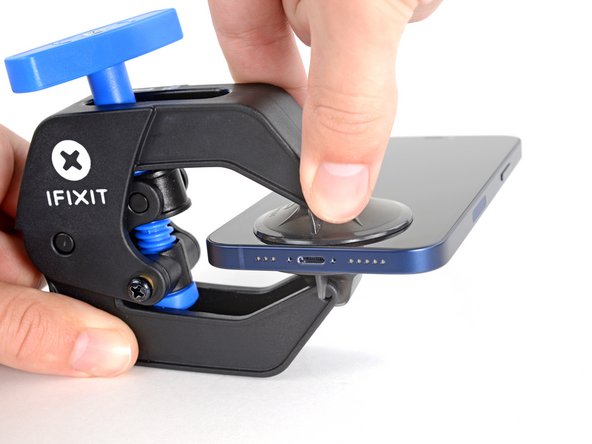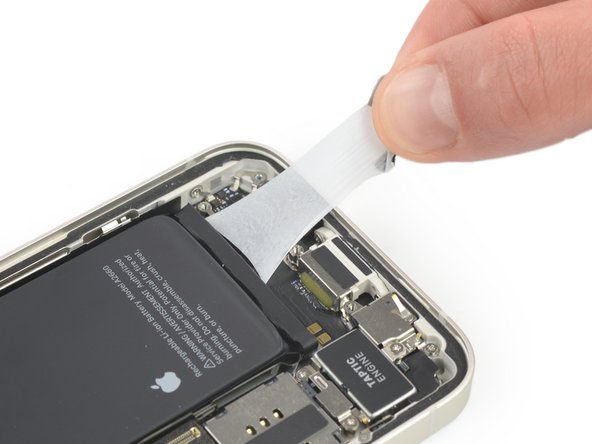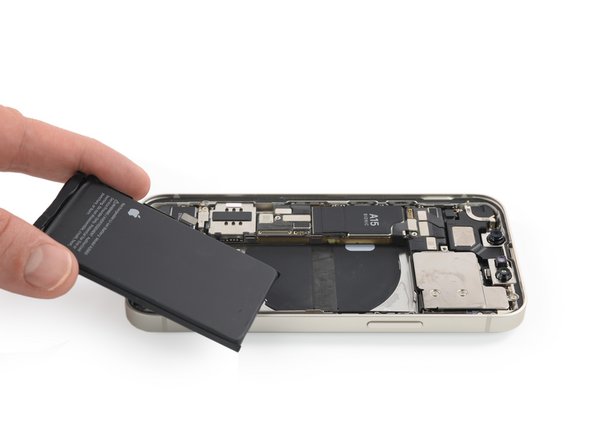iPhone 13 mini Battery Replacement
Duration: 45 minutes
Steps: 34 Steps
iPhone batteries are designed to retain about 80% of their original capacity for around 500 charge cycles, which usually means 18-24 months of use for most people. After that, your iPhone might need more frequent charging, and you might even see a performance warning pop up from iOS (basically, it will feel slower). If you're noticing any of this, it's time to swap that old battery for a fresh one and get your iPhone 13 mini feeling like new again. If your battery's swollen, be sure to handle it carefully. Also, a quick heads-up: If you're running iOS 17.6 or earlier, your iPhone might show a message about the 'authenticity' of the battery post-repair, even if you're using genuine Apple parts. Don’t sweat it though — if everything is working fine, just ignore the warning. On iOS 18 and later, you'll need to authenticate your new battery using Apple's Repair Assistant. And when you're putting everything back together, don't forget to grab some fresh adhesive to reattach those components. If you need help, you can always schedule a repair.
Step 1
- Make sure your iPhone is powered off before you dive into taking it apart.
- Carefully remove the two 6.8 mm-long pentalobe P2 screws located at the bottom edge of the iPhone.
Before diving into the repair, make sure your battery is below 25%. This is a smart move to avoid any sudden heating issues if the battery gets a little too close to the action during the repair. And hey, if your battery is looking a little puffed up, take extra care and stay safe. If you're unsure, you can always schedule a repair for a helping hand.
Popping open your iPhone's display will break its waterproof seals. Make sure you have replacement seals on hand before moving forward, or be extra careful to keep liquids away if you put it back together without new seals.
Step 2
Be careful not to push the opening pick in too far—it's easy to accidentally harm your device. Mark your pick to keep things safe and avoid any mishaps.
Feel free to mark the other corners of the pick with different measurements if that helps you keep track.
Another trick? Stick a coin to your pick, about 3mm from the tip, using tape for a handy guide.
- Grab your opening pick and mark a spot 3 mm from the tip with a permanent marker—precision is key, but keep it chill!
Step 3
Grab your safety glasses before diving in—those tiny glass shards can pop out of nowhere during the repair. Better safe than sorry!
Got a cracked iPhone screen? Put some tape over the glass to keep those shards in check and save your fingers from any surprise pokes during the repair.
If your suction cup isn’t sticking, go wild and glue it to the screen—just don’t get too attached!
- Start by placing some clear packing tape strips over the iPhone's screen, overlapping them until the entire front is covered. Think of it as giving your phone a snazzy tape jacket!
- If the suction cup isn't behaving in the next few steps, no worries! Just grab a sturdy piece of tape (duct tape works great) and fold it into a handy handle to help lift the screen instead.
Step 4
The next three steps walk you through using the Anti-Clamp — our nifty little gadget to help make opening your device a breeze. If you're not using the Anti-Clamp, just skip ahead three steps to check out an alternative method.
Want the full lowdown on how to use the Anti-Clamp? We've got you covered in this handy guide.
If your iPhone is too slippery for the Anti-Clamp to get a good grip, a little tape can do wonders to add some traction.
- Pull the blue handle back to release the Anti-Clamp's arms—easy does it!
- Slide the arms onto either the left or right side of your iPhone, whichever feels right.
- Place the suction cups close to the bottom edge of your iPhone—one on the front, one on the back.
- Give the cups a good squeeze to create suction and get a solid grip on the phone.
Step 5
- Slide the blue handle forward to lock those arms in place—like a handshake for your tools.
- Give the handle a full spin clockwise (360 degrees) or until you see those cups starting to stretch out.
- Keep an eye on the suction cups; they need to stick together like best buds. If they start drifting apart, loosen them up a bit and get those arms realigned.
Step 6
Give it just a quarter turn and chill for a minute between each. Let the Anti-Clamp and a dash of patience handle the tough stuff.
Need a crash course in hair dryer wizardry? Take a look at this guide.
If the Anti-Clamp is being shy and won’t make a big enough gap, hit the spot with a bit more heat and give the handle a quarter twist.
- Set your iPhone on something solid like a hardcover book—hands-free and nice and level is the way to go, trust me. It’ll make your life easier in the next steps.
- Blast the bottom edge of your iPhone with a hair dryer (think spa day for your phone). The screen should get warm—almost too warm to touch, but not burning.
- Give it a minute to let the sticky stuff loosen up and create a little gap for you.
- Once the Anti-Clamp opens up enough space, slide an opening pick under the plastic edge of the screen. Just a little nudge!
- Go ahead and skip the next three steps. You’re cruising!
Tools Used
Step 7
Keep your hair dryer moving—don’t let it hang out in one spot too long!
- Grab your hair dryer or heat gun and warm up the bottom edge of your iPhone for about 90 seconds—just enough so it feels a bit too warm to touch.
Tools Used
Step 8
- Grab your single suction handle and stick it right at the bottom edge of the phone, as close to the edge as you can get. Let’s get a good grip!
Tools Used
Step 9
Be sure to slip that pick between the plastic bezel and the metal frame! If you accidentally wedge it between the glass screen and the plastic bezel, you might end up with a cracked screen. Let's keep that screen safe and sound!
That screen adhesive is seriously tough stuff! Getting that first little gap open takes some muscle. If it’s being stubborn, crank up the heat a bit and gently wiggle the screen up and down to soften the glue. Keep at it until you can slide your tool in without a fight.
- Give that suction cup a good pull with steady, even pressure to pop a little gap between the screen and its frame.
- Now, gently slide an opening pick into that gap beneath the screen's plastic bezel.
Step 10
- Warm up the right edge of your iPhone (the side with the power button) using a hair dryer for about 90 seconds, or until the screen feels just a bit too toasty for comfort.
Tools Used
Step 11
Keep your pick to a max of 3 mm, and remember not to push it through the unheated adhesive sections with force. You wouldn't want it to slip and accidentally bump into any delicate internal parts.
- Glide your opening pick around the bottom right corner and along the right edge of your iPhone, slicing through that stubborn adhesive like a pro.
- Park the pick in the top right corner and let it chill there while you move on to the next step.
Step 12
- Take a hair dryer and warm up the top edge of your iPhone for about 90 seconds, or until it feels a little too hot to comfortably touch.
Tools Used
Step 13
Keep your pick insertion under 3 mm to avoid messing with the top sensors – gentle does it!
- Gently slide the opening pick around the top right corner of the iPhone to loosen the adhesive up there.
- Keep the pick tucked in the top left corner before moving on to the next step.
Step 14
- Crank up your hair dryer and warm up the left edge of your iPhone for about 90 seconds, or until it feels a little too toasty to touch. That heat helps loosen things up for the next steps!
Tools Used
Step 15
Hey there! Just a heads up, there are some fragile cables hanging out along the left edge of your iPhone. It's best to steer clear of inserting your pick here, as you wouldn't want to accidentally give those cables a bad day!
Step 16
Ease into the twist—no need to rush!
If the adhesive is being stubborn, warm up that left edge again.
- Slide a second opening pick into the bottom left corner of your iPhone.
- Gently twist both picks at the same time until the clips along the left edge pop free.
Step 17
- Give that little nub on the suction cup a gentle pull to pop it off the front panel. You've got this!
Step 18
Hold off on fully separating the display for now—there are still some delicate ribbon cables keeping it connected to the logic board. Be gentle and take it slow!
- Turn your iPhone so the right side is facing you.
- Open the iPhone by lifting the display up from the right side, just like opening the front cover of a book.
- Prop the display up against something sturdy to keep it steady while you work on your phone.
- When putting it back together, place the display in position, line up the clips along the top edge, and gently press the top edge into place before snapping the rest of the display down. If it doesn't click in smoothly, check the clips around the display’s edge to make sure none are bent or out of place.
Step 19
- Unscrew the 1.2 mm-long Y000 screw holding down the battery and display connector cover.
- Here's a fun tip: before you seal that display back up, it's a great moment to power up your device and make sure everything's working smoothly. Just remember to turn it off again completely before diving back into the next steps.
- As you work through this repair, make sure to keep track of all your screws and return each one to its original spot. This will help prevent any accidental damage to your device.
Step 20
- Grab your trusty tweezers and gently lift off the cover that’s hiding the battery and display connectors. You've got this!
Step 21
Be super careful not to mess up the sleek black silicone seal that hugs this and other board connections! These little guys work hard to keep water and dust at bay, so let's give them some love!
- Grab a spudger and gently nudge the battery and OLED panel cable connectors up from their cozy spots on the logic board. They’ll appreciate the gentle push!
- Give the connector a little bend away from the logic board. This little dance move prevents it from accidentally getting too close and powering up your phone while you're in the zone fixing it.
- When you're ready to re-attach those connectors, align them just right and press down on one side until you hear that satisfying click. Then, do the same on the other side. But remember, no middle pressing! If things get misaligned, those pins might bend, and we definitely don’t want any permanent damage. Keep it cool and steady!
Tools Used
Step 22
- First up, let's tackle those three screws holding the front sensor assembly cover in place!
- Grab your trusty PH000 screwdriver and remove that 1.4 mm-long screw.
- Next, switch it up with your Y000 screwdriver for the 1.8 mm-long screw.
- And finally, finish strong with the last Y000 screw, which is 1.2 mm-long.
Step 23
- Grab your tweezers and gently lift off the front sensor assembly connector cover with some finesse.
Step 24
- Grab your trusty spudger and gently pop the front sensor assembly cable connector loose. It’s like unplugging your headphones, but way cooler.
Tools Used
Step 25
- Carefully detach the display assembly. It’s like peeling an orange—smooth and steady!
- If you're in the mood to upgrade that waterproof seal around the edges of the display, take a pause here and get it swapped out before moving on!
Step 26
- Take out the four Phillips screws (1.5 mm each) holding the speaker in place.
Step 27
- Grab a trusty pair of tweezers and gently coax the speaker out of its cozy spot.
Step 28
Avoid poking the battery with sharp tools, please! A punctured battery could spill out nasty chemicals or even start a fire. Let's keep things safe and sound!
The battery is held snugly in place on the back cover with three pieces of stretch-release adhesive—two at the bottom of the battery and one at the top.
- Gently peel down the first battery adhesive pull-tab and free it from the bottom edge of the battery. It's like giving the battery a little nudge to start the day!
Step 29
If any of the adhesive strips snap off under the battery and go MIA, no worries—carefully peel off the rest of the strips and keep moving forward as directed.
- Grab that pull-tab with tweezers (or your fingers if you’re feeling bold) and gently tug it toward the bottom of your iPhone 13 mini.
- If the sticky strip snaps, try to fish out the end using your fingers or some blunt tweezers, then keep pulling—just don’t go poking around under the battery.
- Pull firmly to keep the strip moving, but don’t go Hulk-mode. Slow and steady wins here, giving the adhesive time to stretch and let go.
- Skip pressing down on the battery. Keep a good grip on your iPhone by holding the sides.
- Keep the strip nice and flat. Try to pull the whole thing evenly instead of just yanking from the middle or one edge.
- Go for a low-angle pull so the strip doesn’t catch on the battery’s edge.
Step 30
- Carefully grab the wide pull tab using some blunt nose tweezers and gently tug it away from the battery, pulling it down towards the bottom of the iPhone.
Step 31
If the adhesive rips off under the battery and can't be picked up, no worries—just keep moving on to the next step.
- Grab that second pull-tab with your fingers and pull it away from the battery, aiming towards the bottom of your iPhone.
- If the adhesive strip decides to snap, try to snag the end with your fingers or some blunt tweezers and keep on pulling—just don’t wedge anything under the battery.
- Use the same moves as before: avoid pressing down on the battery, keep the strip flat and smooth, and pull it out at a low angle.
Step 32
- Gently grab that nifty pull tab at the top with your tweezers and give it a slow, steady tug away from the battery, guiding it toward the top of your iPhone. You've got this!
Step 33
Hey there! Just a friendly reminder—don't go all Hulk on that battery trying to pry it out. If things are being stubborn, a few more drops of alcohol can help soften that adhesive up. And remember, no squishing or poking the battery with your pry tool—let's keep it safe and sound!
If the sticky stuff under the battery snaps and you can't fish out the end, grab some high-strength (over 90%) isopropyl alcohol and drip a little under the battery edge where the adhesive gave up. Let it loosen things up before you keep going.
- Just like before, give that last tab a gentle tug to stretch it out and peel away the remaining adhesive strip that's keeping the battery cozy. Just be careful not to let it stick to anything else!
- Take a breather for about a minute while the alcohol solution works its magic on the adhesive.
- Now, grab the flat end of your trusty spudger and gently nudge the battery up. You've got this!
Tools Used
Step 34
- Fire up your device to double-check your repair skills before sealing everything up—better safe than sticky.
- Stick down the fresh battery using pre-cut adhesive or double-sided tape. Lay the adhesive in the spots where the old stuff was, not on the battery itself. Give the battery a solid press to lock it in place.
- Put your device back together by reversing the steps above. If you see any leftover gunk, wipe it down with isopropyl alcohol (>90%) before laying down new adhesive.
- Got a new part that needs calibration? As of iOS 18, use Apple’s Repair Assistant: Update your device, head to Settings→General→About→Parts & Service History, tap Restart & Finish Repair, and follow the prompts.
- For best results, let your new battery have its moment—calibrate it after installation for top performance.
- Don’t toss your old parts in the trash! Drop off e-waste at an R2 or e-Stewards certified recycler and keep things green.
- If things didn’t go as planned, try some basic troubleshooting or check with the iPhone 13 mini Answers community. If you’re still stuck, you can always schedule a repair.















































































